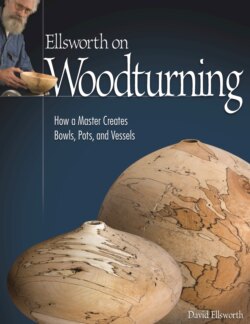Читать книгу Ellsworth on Woodturning - David Ellsworth - Страница 22
На сайте Литреса книга снята с продажи.
The mechanics of sharp
ОглавлениеLet me begin with some very basic concepts of tool design that affect all tools, the first stage of which is learning the mechanics of sharp. Without understanding what a tool is designed to do, and what it looks like, you won’t have a clue about how to shape it, sharpen it, or put it to work on the wood.
For instance, let’s say you get up in the morning, eat breakfast, grab your razor, and shave. Then you fetch your ax and go out and cut down the tree you want to make some bowls from. After lunch and a nice nap, you buck up the sections of the tree with a splitting maul. The razor, the ax, and the maul are all cutting tools in some form. They are very efficient tools, but each has a specific function, and none can be used to perform the tasks of the others…at least not very efficiently.
From a woodturner’s perspective, look at the cross-section sketches of the tools shown at left and think of the relationships between the razor and skew, the ax and gouge, and the maul and scraper. They all have two surfaces, or planes, that join to form an edge, and each has a certain amount of mass that supports (or doesn’t support) that edge—the razor having the least amount of mass, the maul the most.
The skew has a sharper edge, but because there is so little mass behind it, the edge doesn’t stay sharp for very long. It lacks durability. In effect, the less mass a tool has to support the edge, the less durable that edge will be when cutting the wood.
Scrapers, on the other hand, have plenty of mass behind the edge, so they’re good at holding their edge. Of course, they never get very sharp because of the broad angle of the two planes that form the edge, which is why you apply a burr so they will cut the wood.
Gouges, then, are the compromise between these two types of tools. With their moderate amount of mass behind the edge, they sacrifice some of the sharpness of the skew, but they gain the durability of the scraper.
